In the intricate dance of customer connections to improve engagement, a gap often lingers—a disconnection between actions and the emotions they should evoke.
Your audience, a dynamic tapestry of emotions across their journey, demands more than surface-level personalization.
While many organizations embark on the path of improving the way they connect with customers, the tendency to limit personalization to mere names prevails, even in personalized videos.
For example, addressing customers by name is a commendable first step, but the real power lies in comprehending the rich tapestry of their emotions.
Witness the undeniable link between emotional connections and business success through compelling real-world examples.
Picture a Millennial-focused credit card experiencing a 70% surge in usage and a 40% spike in new accounts, simply by prioritizing emotional connection.
Similarly, a household cleaner not only reversed market share losses but achieved double-digit growth within a year by emphasizing emotional engagement.
The narrative extends to one of our clients, a welfare-to-work provider, boosting employee engagement through personalized videos that tap into well-being similar to the following:
Despite these rewards, many companies grapple with the ambiguity of building emotional connections.
This is where groundbreaking research, meticulously detailed by Harvard Business Review, offers a strategic breakthrough—a roadmap to infuse emotional intelligence into personalized engagement initiatives.
Emphasizing that these insights are not theoretical, the research provides a practical guide to crafting personalized videos that resonate with your audience’s emotions, thereby enhancing effectiveness and ROI.
The central theme resounds: personalized videos transcend mere visual appeal; they are powerful catalysts forging genuine connections.
Understanding and addressing the emotional drivers of your audience can elevate engagement and, consequently, increase returns on investment.
This journey into the realm of emotional connections with customers is not just an analysis; it’s a practical guide for organizations seeking to transform personalized engagement into a potent tool for success.
Dive into the Harvard Business Review’s research findings, and discover the keys to unlocking deeper, more meaningful connections with your audience.
Emotional Motivators: A Strategic Science
Extensive research introduces the concept of “emotional motivators,” defining them as the feelings that propel customer behavior.
These motivators emerge as a superior metric for gauging a customer’s future value compared to conventional measures like brand awareness and customer satisfaction.
Understanding and targeting these motivators is essential. By doing so, you can concentrate on tactics and strategies that are aligned with the preferences of your customers.
This alignment will ultimately lead to effective personalized customer experiences, resulting in a direct positive impact on your engagement metrics.
For instance, as you’ll see later in this article, it explains why contextualized and personalized videos can be 116% more effective than generic videos.
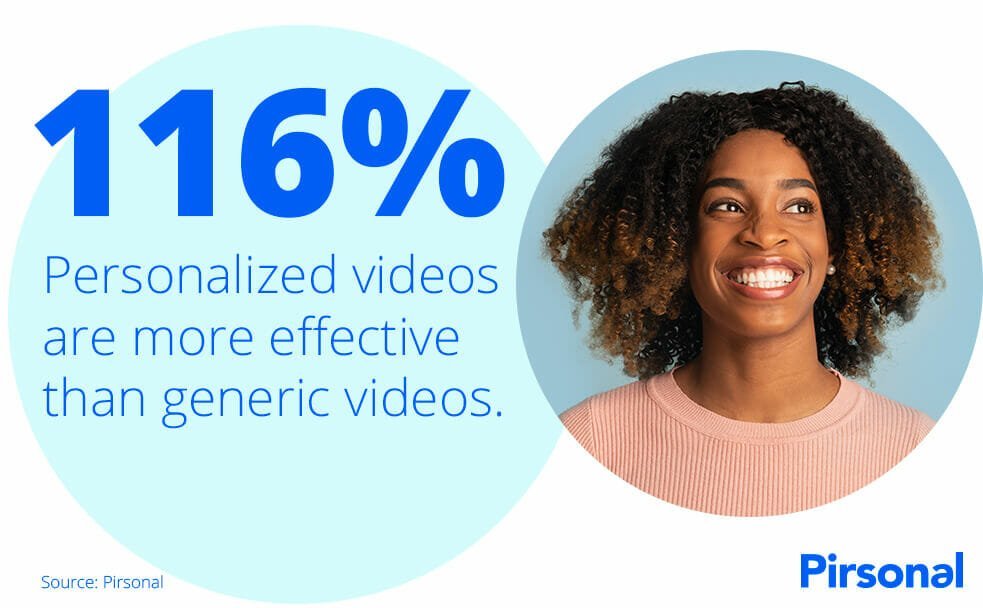
Personalized videos perform better than generic videos in 1:1 marketing
Decoding Emotional Motivators: A Unique Lexicon
The customer connections journey begins with a lexicon of emotions. To tackle the inconsistency in defining and connecting with customer emotions, the researchers curated a list of over 300 emotional motivators.
Brands achieve emotional connection when they align with customers’ motivations, tapping into deep, often unconscious desires.
They have truly understood the importance of customer engagement.
Examples include the desire to “stand out from the crowd,” “have confidence in the future,” and “enjoy a sense of well-being.”
We created the following infographic to show the top 10 emotional motivators highlighted by the researchers.
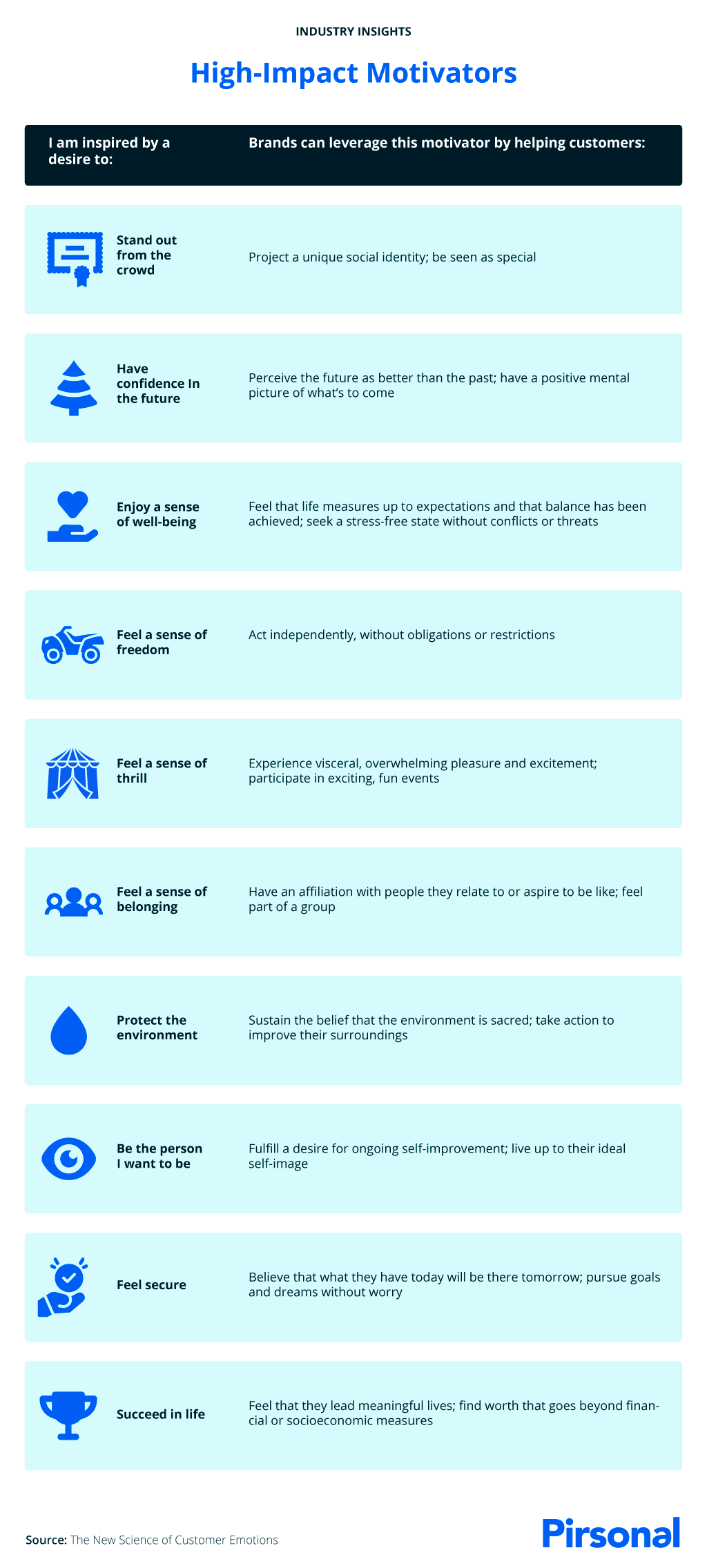
Infographic showing high-impact emotional motivators in customer engagement and personalization
Identifying and measuring these motivators is intricate, given that customers might not be consciously aware of them.
Moreover, emotional customer connections vary across industries, brands, touchpoints, and customer positions in the decision journey.
For instance, when making personalized videos to boost customer engagement, it’s important to connect with various emotions to better engage with individuals who are at the same stage of the journey.
Picture an insurance company seeking to boost renewal rates. Rather than sending out generic renewal messages to all clients each month, the company could opt for a more strategic approach.
The following infographic explains this process.
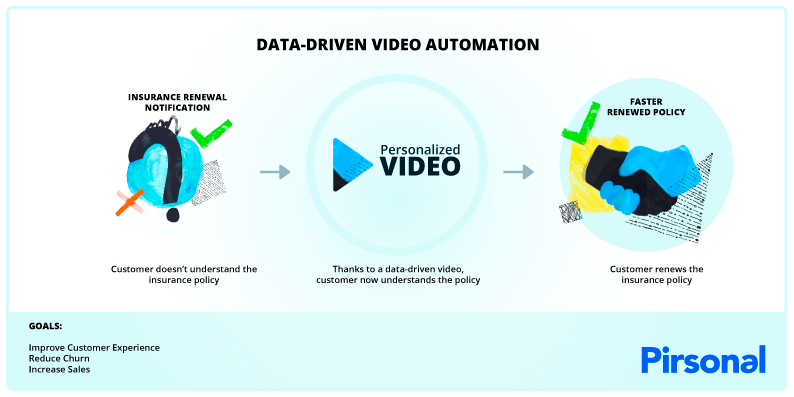
Improved customer experience and faster policy renewal with personalized videos
By customizing messages based on the unique circumstances and emotional triggers of different client segments, the company can establish a more personal connection that is bound to enhance the renewal experience.
This, in return, will help them boost renewal rates.
This means that “Mark’s” video could focus on “feeling secure” because he is a new dad, while “Jennifer’s” video focuses on “protecting the environment”, even when in both cases the brand is helping them renew an insurance policy.
As I always emphasize, personalized communications are crucial. The effective ones go beyond data and consider the context of each customer.
By aligning these interactions with your business goals, you can significantly enhance the impact of your personalized messages.
The Significance of Emotional Customer Connections
While brands may be liked or trusted, many failures to align with customers’ most profitable behaviors stem from a lack of connection with their emotions.
This research demonstrates that fully connected customers, traversing the emotional connection pathway, are 52% more valuable on average than highly satisfied customers.
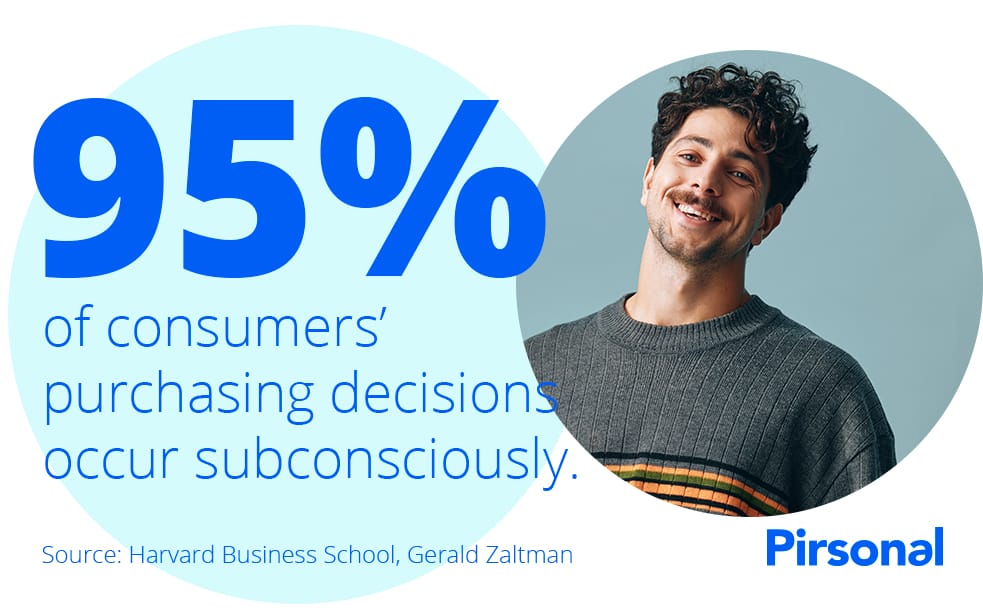
Most buyers make decisions subconsciously
Therefore, moving dissatisfied customers to full emotional connection yields higher returns than simply turning them into satisfied customers.
For instance, take a look at the following infographic we made to explain this with information from Motista.
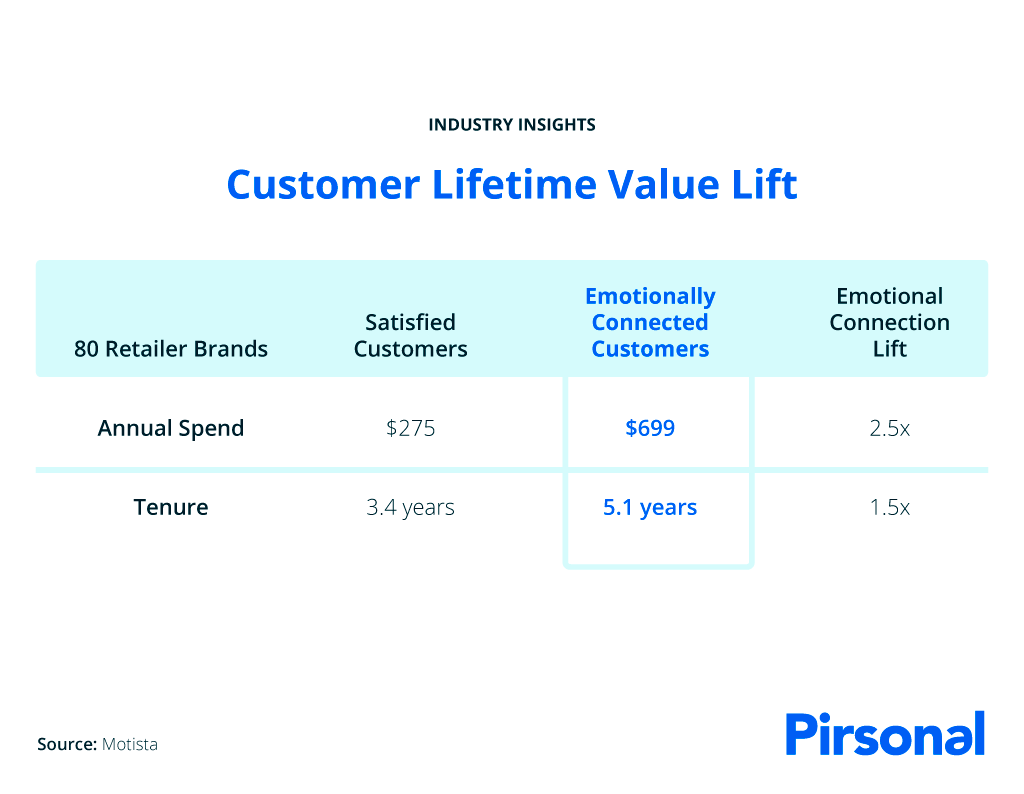
Customer lifetime value Lift from emotionally connected customers
As you can see, there is a lift in terms of customer lifetime value (LTV) when the customer is emotionally connected, which is one of the reasons why brands invest in personalized videos.
4 Strategic Insights from Emotional Connection Research
Now, let me summarize the key insights from this research and how it played a pivotal role in initiatives launched by brands like yours.
#1 Emotional Motivators Are Varied and Category-Specific
Out of the 300-plus motivators identified, 25 significantly impact customer value across diverse categories.
Additional motivators, ranging from five to 15, play a crucial role in specific categories.
For instance, a home furnishings store’s appeal may hinge on helping customers be creative, while a fast-food restaurant gains loyalty by providing a sense of revival and refreshment.
#2 Segment-Specific Emotional Motivators
Emotional motivators differ among customer segments. Tailoring strategies to specific motivators proves essential for success.
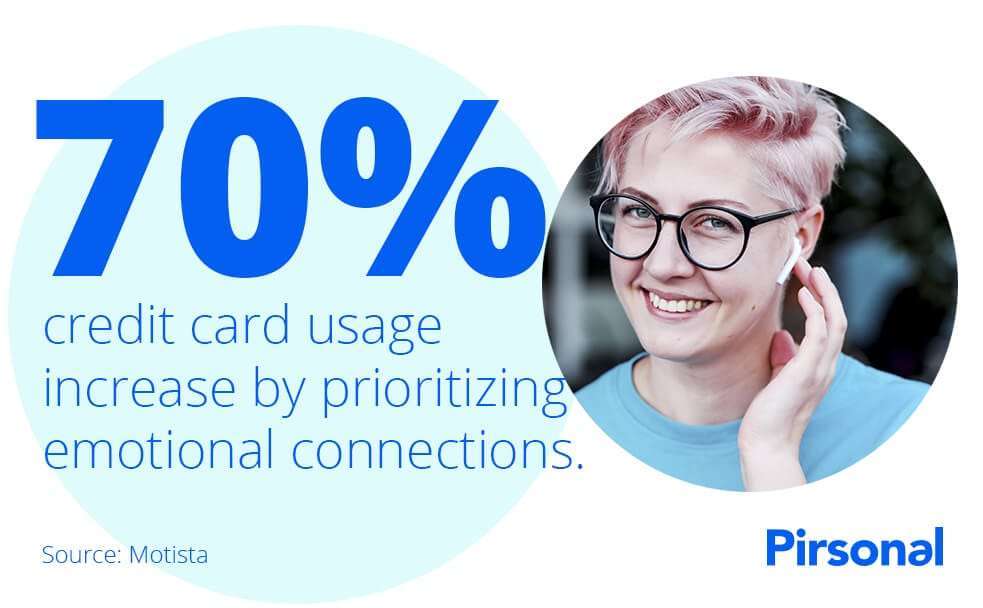
The example of a credit card designed for Millennials, which identified desires to “protect the environment” and “be the person I want to be,” illustrates the efficacy of segment-specific emotional connection.
#3 Dynamic Emotional Motivators Along the Customer Journey
The importance of emotional motivators shifts along the customer journey.
For example, in banking, the desire to “feel secure” is crucial in the early stages of attracting and retaining customers, while the wish to “succeed in life” gains prominence in cross-selling products later.
Therefore, aligning emotional connection strategies with specific customer-engagement objectives is key for optimal results.
#4 Emotional-Connection-Driven Growth Across Customer Experience
Emotional connection opportunities extend beyond traditional brand positioning and advertising.
Personalized email marketing, for example, can significantly impact emotional connection if the content of the emails aligns with the audience’s context.
For example, we helped a known car brand increase its direct mail response rate by 500% compared to the industry average. We achieved this by creating personalized videos where the brand ambassador thanked the customer.
The brand’s ability to establish an emotional connection between a familiar face, the brand ambassador, and the customer through a personalized video and other carefully crafted marketing materials played a pivotal role in the unprecedented success of its latest campaign.
Implementing Emotional Connections: A Strategic Blueprint
These are the steps recommended by the experts to successfully implement emotional connections in your customer experience, engagement, and marketing initiatives.
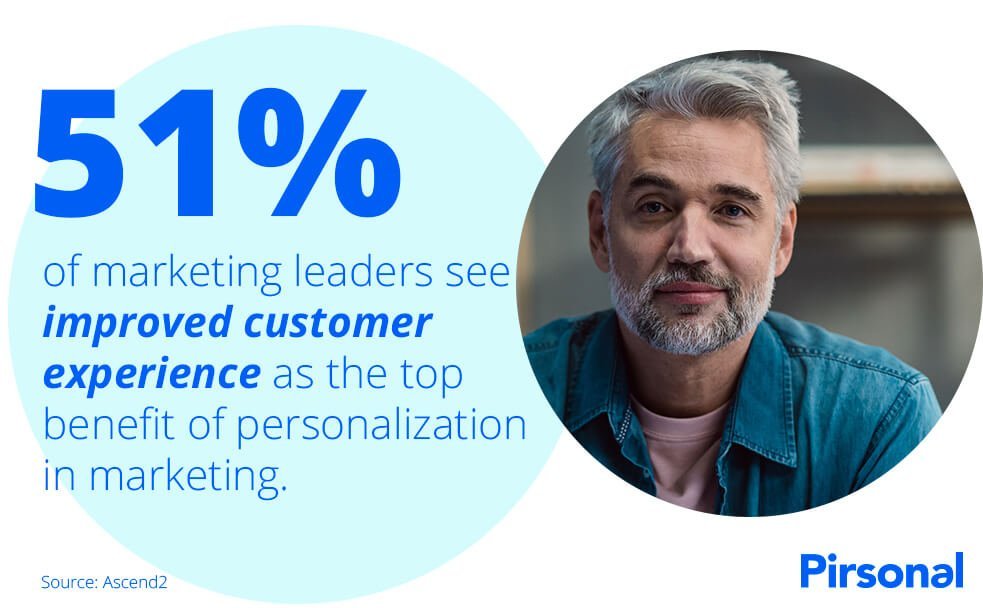
Personalization in marketing has a key benefit: improving customer experience.
#1 Target Connected Customers
Identifying and attracting emotionally connected customers prove pivotal. By measuring the strength of emotional connections and segmenting customers, companies can discern valuable opportunities.
A case study of a national fashion retailer, categorizing its most emotionally connected segment as “Fashion Flourishers,” illustrates the potential gains. Flourishers, representing just 22% of customers, contributed to 37% of revenue, spending twice as much annually as highly satisfied customers.
These are the stages:
- Unconnected
- Highly satisfied
- Perceiving brand differentiation
- Emotionally connected.
#2 Quantify Key Motivators
In-depth analysis and quantification of motivators guide strategic investments.
As a case in point, our client, a provider of welfare-to-work services, discovered that numerous employees lacked knowledge and understanding of the benefits offered by the organization.
In order to address this issue and enhance employee engagement and retention, they devised personalized videos that not only successfully clarified the available benefits but also highlighted the individual advantages employees were missing out on.
These videos were focused on the employee’s “well-being”, which is a key emotional motivator.
The results were highly successful, effectively conveying the information and showcasing the significance of these benefits to the employees, exceeding the average audience engaged with the personalized video content in HR communications.
“Love this… and what a great thing to send to each individual highlighting what we are lucky to get!”
Understanding the impact of these motivators on purchasing, spending, loyalty, and advocacy enables targeted and high-return investments.
#3 Optimize Investments Across Functions
To maximize emotional connection opportunities, a holistic approach is essential. For example, the fashion retailer examined every function and touchpoint, from stores to online experiences, merchandising, and message targeting.
Detailed analytics identified high-scoring stores serving Flourishers, leading to optimized store locations.
Investments in online and omnichannel experiences were guided by quantifying the impact of touchpoints. Merchandising and message targeting were optimized based on the identified key motivators.
#4 Systematize, Measure, and Learn
Embedding emotional connection strategies into existing workflows requires systematic measurement and learning.
In my opinion, this is one of the most challenging aspects of this approach for average teams and one of the reasons why many organizations rely on third-party help.
For example, the fashion retailer adopted a scorecard approach, providing a comprehensive view of customers’ progression on the emotional connection pathway.
Correlating emotional connection scores with LTV measures, tracking impacts on in-store and omnichannel touchpoints, and incorporating emotional connection metrics into ongoing testing facilitated a holistic and data-driven approach.
Results: A Startling Transformation
The fashion retailer’s journey illustrates the tangible outcomes of embracing emotional connection strategies.
Same-store sales for stores serving Flourishers realized a 3.5% growth over the past year, outperforming the five-year average of 1%.
Inventory turns increased by more than 25%, and market share and customer advocacy witnessed significant growth.
The underlying success was a 20% rise in the company’s emotional connection score, emphasizing the impact of moving satisfied customers to full emotional connection.
This Approach Needs Your Full Organization Involvement
Implementing an emotional-connection strategy necessitates organizational alignment, deep customer insights, and a managerial commitment to a new way of thinking.
This is what most managers and C-level executives will agree with. However, in my opinion, it also requires that the complete organization understands that customers go through different stages and emotions as they interact with the brand, regardless of the channel.
Therefore, rather than restricting the strategy to marketing, companies should foster cross-functional collaboration.
Conclusion: Crafting Your Personalized Journey with Emotional Connections
As we wrap up this exploration into the dynamic realm of emotional connections, envision the transformative potential for your brand. In a landscape where customers yearn for authentic engagement, the strategic embrace of emotional motivators becomes your key to unlocking lasting connections.
At Pirsonal, we’ve witnessed firsthand the remarkable impact of personalized videos in captivating audiences at every touchpoint of their journey.
Picture your brand resonating with customers not just as consumers but as individuals with unique desires and aspirations.
Your Next Step: A Tailored Conversation with Us
Ready to harness the science of emotional motivators to propel your customer engagement to new heights?
Let’s start a conversation tailored to your specific situation and goals. Our team at Pirsonal is eager to understand your brand’s narrative, explore your challenges, and provide customized recommendations to captivate your audience through personalized videos.
Don’t let the potential for deeper connections slip away.
Contact us now, and let’s embark on a journey to elevate your customer engagement through the strategic infusion of emotional connections. Your audience is waiting for an experience that goes beyond the ordinary.
Let’s make it happen together.

